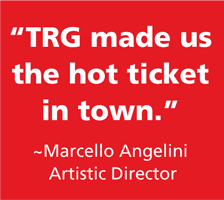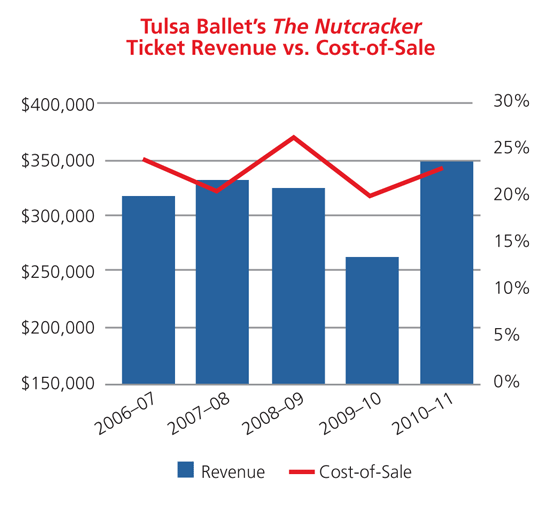Record-Breaking Nutcracker
The Scenario:

Tulsa Ballet’s annual production of
The Nutcracker had performed well in previous years, but in 2009, both total tickets sold and revenue dropped by about 20%. As for many ballet companies,
The Nutcracker was usually a high-demand show and bolstered the company’s financial health for the rest of the season. So why was revenue on the decline?
Low cost-of-sale.
“Cost-of-sale” refers to matching anticipated revenue to the marketing investment. Tulsa Ballet was investing a disproportionate amount into marketing productions with niche audiences and not putting enough into marketing blockbusters like
The Nutcracker, where the Company will make the most return-on-investment.
Pricing vs. demand.
Because
The Nutcracker is a production that attracts many families, Tulsa Ballet wanted to keep seats affordable. Tickets for
The Nutcracker were $15-$55, with most seats between $15 and $35. That made tickets for
The Nutcracker, Tulsa Ballet’s most in-demand production, less expensive than other productions, which were priced at $20-$70.
Perception of success.
In 2009,
The Nutcracker only sold 53% of its possible capacity. Due to the location of pricing sections – cheap seats in the back of the hall and too many expensive seats up front – there were “holes” of empty seats in visible locations. These empty seats reinforced negative messages to
Nutcracker audiences, especially the thousands of households who were experiencing the ballet for the first time ever. Empty seats can signify that demand is low and that advance purchasing is not worth it.
Results:
After working with TRG for three months, Tulsa Ballet saw the following:
-
Their 2010 production of The Nutcracker earned 33% more revenue over the previous year, shattering box office records. Revenue was up 8% over the previous high.
-
A greater perception of success in the community. As Artistic Director Marcello Angelini said “TRG made us the hot ticket in town.”

How they did it:
Re-scaling, re-pricing.
Tulsa Ballet rearranged where price points were located in the hall. $15 seats from the balcony were moved to visible and less popular areas on the main floor. TRG consultants recommended higher prices, including dynamic pricing, through the mid-range prices of $25-$35.
Spend more to make more.
The biggest change Tulsa Ballet made for 2010-11 was to invest more heavily in its biggest revenue-producing productions. TRG consultants looked at the cost-of sale for the Company’s most successful
Nutcracker and advised Tulsa Ballet to invest at a comparable ratio of expected revenue. The Company reallocated resources from lower-demand productions, which had minimal impact on other production’s sales outcomes. By spending more on
The Nutcracker, Tulsa Ballet created enough buzz to increase interest and generate 33% more revenue than the previous season.
About Tulsa Ballet:
Tulsa Ballet is $5 million ballet company based in Tulsa, Oklahoma that produces 6 classic and modern ballets annually for more than 40,000 attendees.